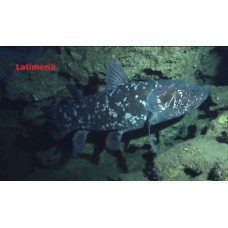Species that once had a very wide distribution are now found only in a limited area as a remnant of a past geological epoch or fauna. They are known as remnant species. They are often rare or extinct.
For example: Latimeria is a genus in the family Latimeriidae, Coelacanthiformes. It is a living fossil. Two species of Latimeria are currently known: Latimeria chalumnae, discovered in 1938 and found off eastern and southern Africa, and Latimeria menadoensis, discovered and described in 1997-1999 near the island of Sulawesi in Indonesia.
For a long time it was thought that the coelacanths had remained virtually unchanged for 400 million years. However, modern research shows that this group is not characterised by morphological stasis or delayed genome evolution.
Coelacanthiformes belong to the Actinistia group, which for most of its evolutionary history was mainly marine.
Relatively distant relatives of Coelacanthiformes, the shovel-finned fishes of the Rhipidistia group, became the ancestors of all terrestrial vertebrates (this group also includes modern typhantes; genome studies have shown that modern tetrapods are closer to typhantes than to celacanthids).
Members of the order Coelacanthiformes have evolved peculiar anatomical structures, many of which are synapomorphic for this order.
For example, instead of the hard backbone characteristic of the majority of jawed vertebrates, Coelacanthiformes have a thick-walled elastic tube that is as far removed from its ancestral chord as other vertebrate backbones, but this structure has evolved in a completely different direction.
Instead of a solid skull, coelacanths have a peculiar two-part braincase, which (like other shovelnose fishes) is articulated by an internal joint reinforced by the basicranial muscle.
Coelacanthiformes are the only modern animals with this cranial structure. The intracranial joint, together with other unique rotational joints in the head, specific rostral organs and an electrosensory system consisting of a network of channels, including those that penetrate the gular plates, ensure the process of "suction feeding" and explain such a characteristic feature of Coelacanthiformes behaviour as hanging upside down, first observed by the ichthyologist Hans Fricke. Genetic studies have shown that Latimeria are more closely related to bivalves (Dipnoi) and tetrapods (Tetrapoda) than to ray-fishing fishes (Actinopterygii).
Relict species (relicts)
Tags: Relict species (relicts)

